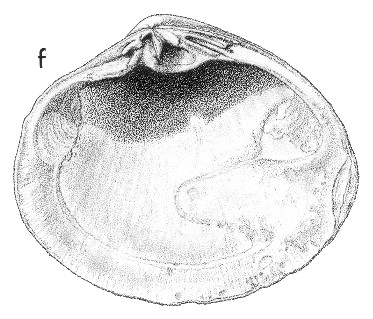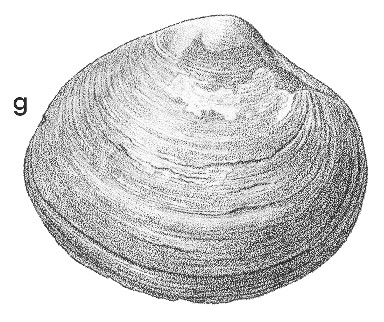
Revised descriptions of New Zealand Cenozoic Mollusca from Beu and Maxwell (1990)

 | Revised descriptions of New Zealand Cenozoic Mollusca from Beu and Maxwell (1990) | 
|
  (Pl. 45f): "upper beds", Motunau Beach, North Canterbury, Haweran (GNS; coll. by Sir J. Hector, 1873), |
  (Pl. 45g): "upper beds", Motunau Beach, North Canterbury, Haweran (GNS; coll. by Sir J. Hector, 1873), |
Beu & Maxwell (1990): Chapter 16; p. 342; pl. 45 f,g.
Synonymy: Spisula ovata Gray 1843, p. 251; ? = Mactra tristis Deshayes in Reeve 1854, pl. 14, fig. 69; ? =Mactra inflata Hutton 1873b, p. 18; ? = Mactra rudis Hutton 1873b, p. 19; Standella aequalis Webster 1905, p. 280; Mactra ovata
Type species of Cyclomactra Dall, 1895
Classification: Mactridae: Mactrinae
Description: Large for family (60-75 mm long), oval to subtriangular, strongly inflated, thin and fragile, most shells with thin hinge; exterior smooth apart from weak commarginal growth ridges. Hinge plate very thin, with deep, widely triangular resilifer in each valve, separated from external ligament by a thin plate; prominent, thin, anterior and posterior lateral teeth in each valve; a prominent, solid, relatively small, deeply bifid cardinal tooth in left valve and matching pair of widely spread, thin cardinal teeth in right valve. Both adductor scars moderately large, equidimensional; pallial sinus deep, with rounded anterior end.
Comparison: The taxonomy of Cyclomactra is very poorly understood, and probably cannot be resolved without sophisticated genetic techniques. Some large shells (including the figured one) develop a thicker hinge and thicker, shorter, more ventrally directed lateral teeth than smaller shells, and the outline is highly variable. Traditionally, 2 species have been recognised, C. tristis being the more nearly circular and found deeply buried in estuaries, and C. ovata being the more triangular and living deeply buried off oceanic sand beaches. It seems possible that the named younger forms are all one species, varying with environment, but this has not been resolved. Boreham (1965) illustrated the lectotypes of Mactra inflata and M. rudis, considering them to be the same species as the Recent C. ovata and C. tristis, respectively. However, the shape separation is not as clear-cut in the modern fauna as this suggests, and near-circular shells similar to the lectotype of M. rudis have not been seen in the modern fauna. Much more study is needed of the variation and ecology of the genus. The Waipipian C. williamsi (Otahuhu Brewery well) is smaller and more inflated than the younger C. ovata/tristis forms. Although we suggest a conservative alternative here, the other alternative (all nominal species are valid) is adopted in the checklist.
Although no really typical species of Cyclomactra are known earlier than Waipipian, "Eumarcia" altilunula proves to be a member of a species group (other known members are unnamed) in Oligocene to Late Miocene fully marine faunas that has a very thin shell and very thin hinge similar to that of Cyclomactra, but differs in its more nearly trigonal shell shape and its weaker inflation. This group is possibly ancestral to younger species included in Cyclomactra, but needs further study.
The figured specimen is a topotype of Mactra inflata, but apparently not a syntype; the lectotype was collected from the "upper beds" (i.e., Haweran terrace cover) at Motunau Beach by Buchanan in 1867 (Boreham 1965, p. 66) whereas the figured specimen still bears its original label stating that it was collected from the "upper beds" at Motunau Beach by Sir James Hector in 1873. Interestingly, the figured shell is the rudis (= tristis ?) form, not the inflata (= ovata) form.
Distribution: Waipipian(?)-Recent; Recent, New Zealand (types of Spisula ovata, Mactra tristis, and Standella aequalis); Haweran terrace cover beds at Motunau Beach, North Canterbury (lectotype of Mactra inflata); "upper beds" at Castlecliff, Wanganui, Castlecliffian (lectotype of Mactra rudis). Cyclomactra ovata lives deeply buried in the mud of estuaries, and less commonly off sheltered sand beaches, and occurs commonly as a very young fossil in estuarine faunas, with Austrovenus.
Cite this publication as: "A.G. Beu and J.I. Raine (2009). Revised
descriptions of New Zealand Cenozoic Mollusca from Beu and Maxwell (1990). GNS
Science miscellaneous series no. 27."
© GNS Science, 2009
ISBN
978-0-478-19705-1
ISSN 1177-2441
(Included with a PDF facsimile file
copy of New Zealand Geological Survey Paleontological Bulletin 58 in CD version
from: Publications Officer, GNS Science, P.O. Box 30368 Lower Hutt, New
Zealand)